Learn in this post how to make a beautiful, Japanese apron with cross-back straps. This apron is perfect for fall, displaying cozy fall colors and patterns. It’s an easy project, resulting in a lovely apron with large, practical pockets.
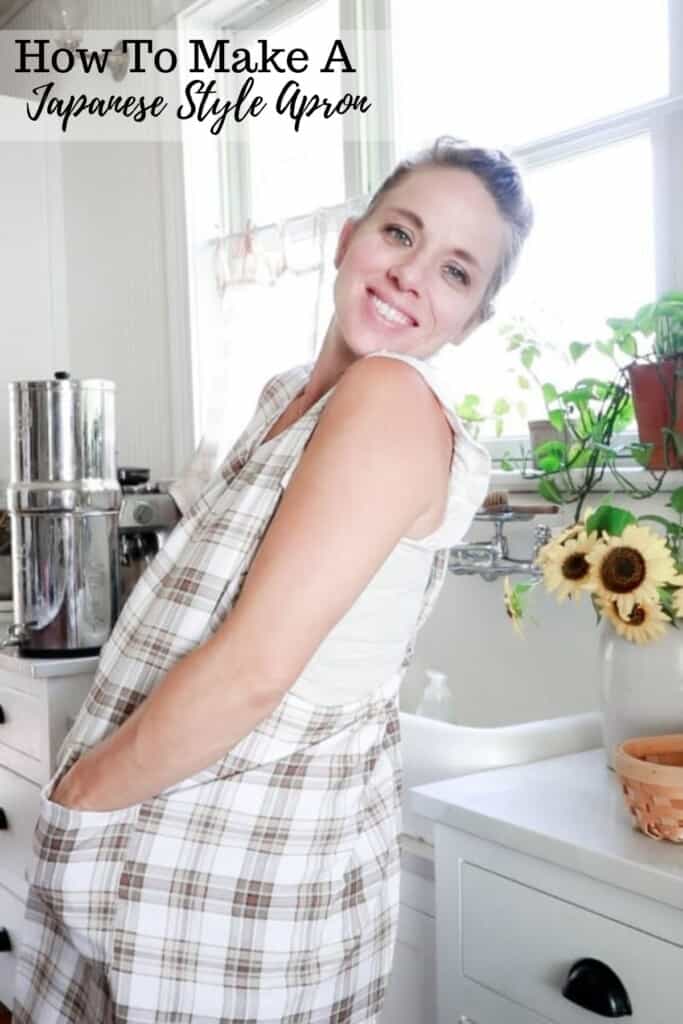
It is definitely starting to feel like fall around the farm. This morning when I went out to do the chores, I had to throw on a sweater. However, the garden is still blooming, as we haven’t had a frost yet.
We are starting to make more recipes with bone broth and comforting ingredients like root vegetables, meats, and creamy additions. Pumpkin spice has started to make an appearance as well, with a pumpkin chai in the afternoon. The house is starting to shift from summer to a cozier fall atmosphere.
The whole house got a fluffing to bring in those textures, colors, and the indoor warmth of fall. We rearranged all of the bedrooms to fit our current life circumstances. Our bedroom was moved to what was the living room. It is so nice to have a door in our bedroom that leads out to our side porch, to enjoy coffee in the mornings. So while I was making the bed and fluffing the linens, the screen door allowed that fall breeze to blow through.
It’s the beginning of the cozy, dreamy fall season.
This post contains affiliate links, which means I make a small commission at no extra cost to you. See my full disclosure here.
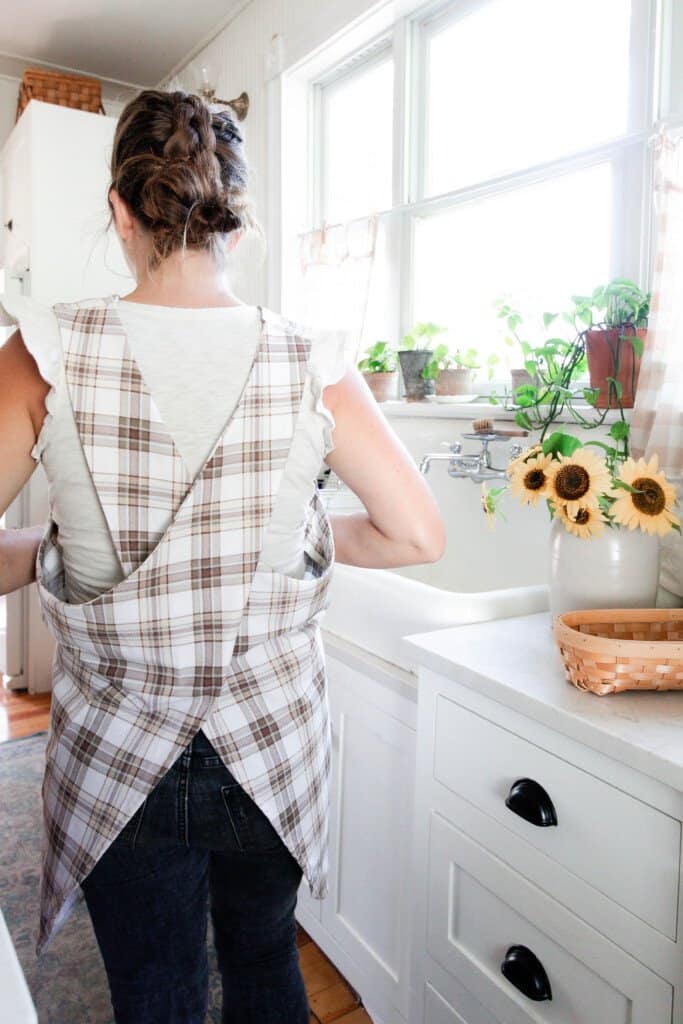
Creating A Fall Inspired Japanese Apron
One thing that I wanted to do was sew a new Japanese style apron to hang on the wall with those lovely fall colors. So I headed to Walmart and picked up some fabric from Better Homes and Garden.
They have this Brother sewing machine that I have purchased for two of my children and for myself. They also have Better Homes and Garden two-yard, pre-cut fabric and a wide variety of fabrics. I’ve been purchasing fabric from Walmart for many, many years.
In our old town, we didn’t have a fabric store for 30 miles. Walmart was the only place nearby to purchase all the things needed for sewing projects, for which I was super grateful.
I actually created a Japanese apron printable pattern for you to be able to easily print it off and create this project. You can either print it off at home and tape it together, or take it to a print shop and print it off on a large piece of paper. It ended up costing me about $6 to get it printed.
This was a really simple project, and if you love the farmhouse style like I do, hanging aprons out on hooks compliments wicker baskets, pitchers of flowers, and wooden cutting boards. And so for me, aprons are part of the decor. If I have any leftover fabric, I’ll use it to create a tea towel, or have my daughter make a hot pad, just to display more of that cozy fall fabric.
Tools you may need:
Brother full size sewing machine
Better Homes & Gardens 100% Cotton 72″ x 45″, 2 Yard Precut Fabric Plaid Color
Dritz long pearlized pins, size 24
Bias tape
All purpose white thread
Sewing scissors
Cordless iron
Another great fall plaid fabric option
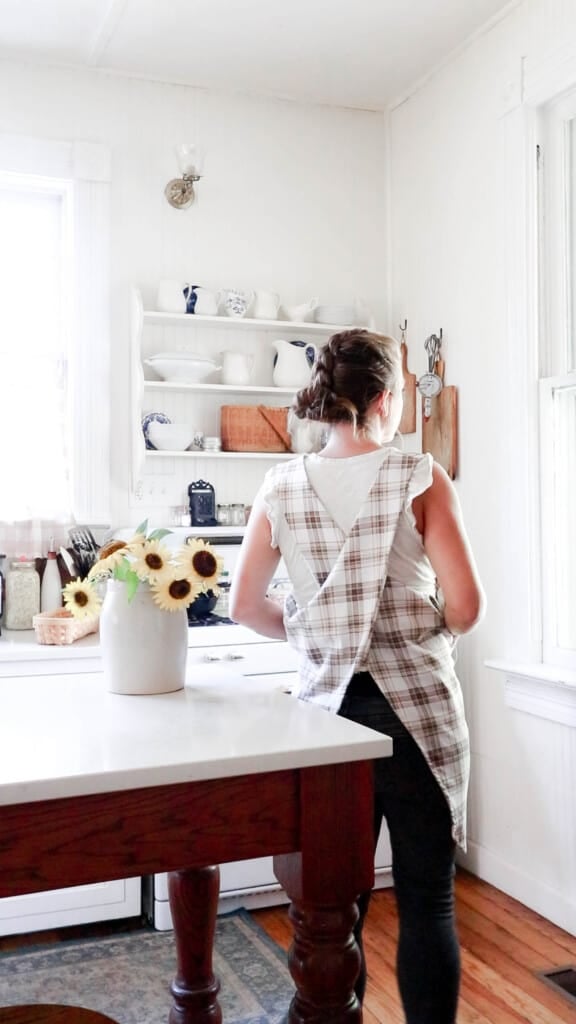
How To Make A Japanese Apron – Cross-Back Apron
Click HERE to download the pattern in full size.
Click HERE to print the pattern on your home printer.
Pattern for home computer
Pattern for print shop
Cut out the paper pattern.
Wash, dry, and iron fabric. This is good to do before sewing any project, to prevent the fabric from drying funky after the project has been made.
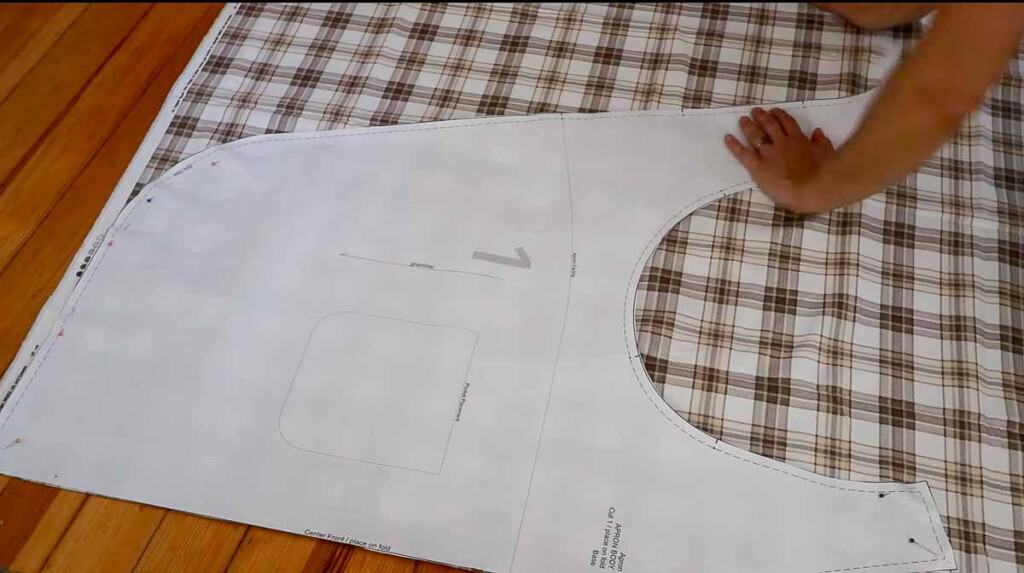
Fold the fabric in half and place the large, main section of the pattern along the fold and pin in place. You have to place the pattern very strategically so that it fits a two-yard piece of fabric.
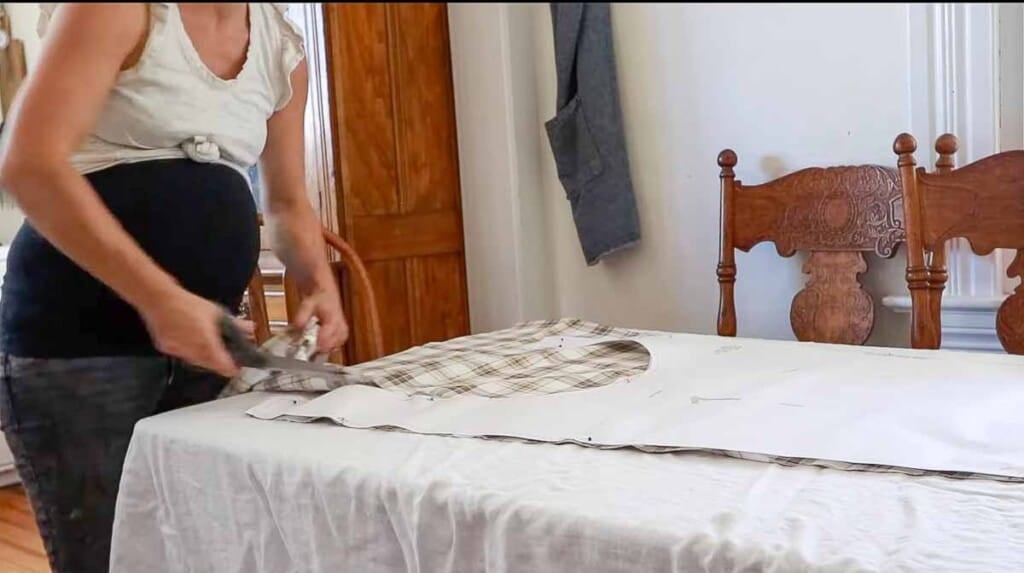
Cut out the pattern. If you are only using two yards, you will have to cut the interfacing in two spots rather than on the fold, adding a little extra fabric to one side in order to sew it together down one side.
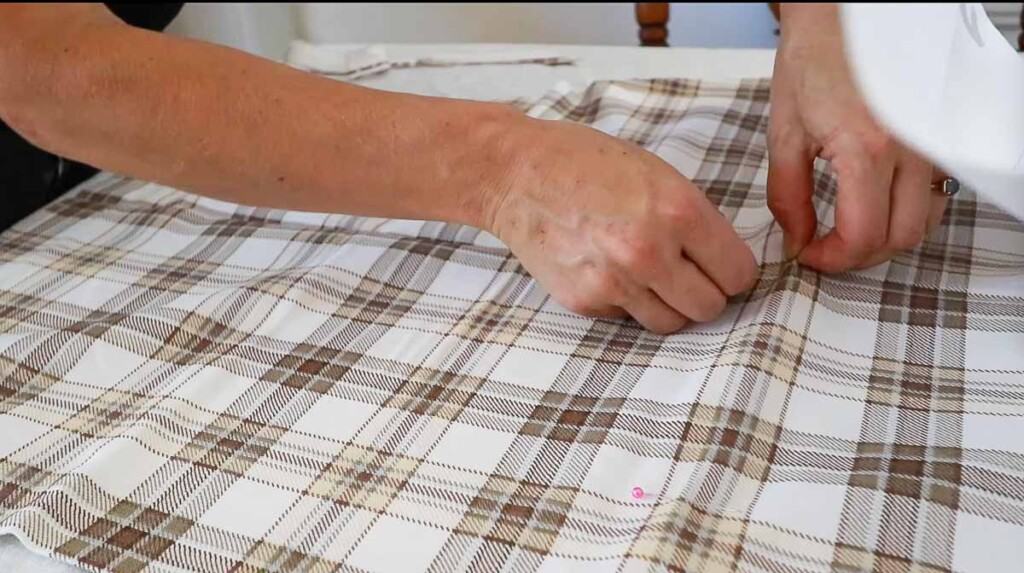
While the pattern is still somewhat pinned on, place pins to mark where the pockets belong. I added four pins at the corners to mark it.
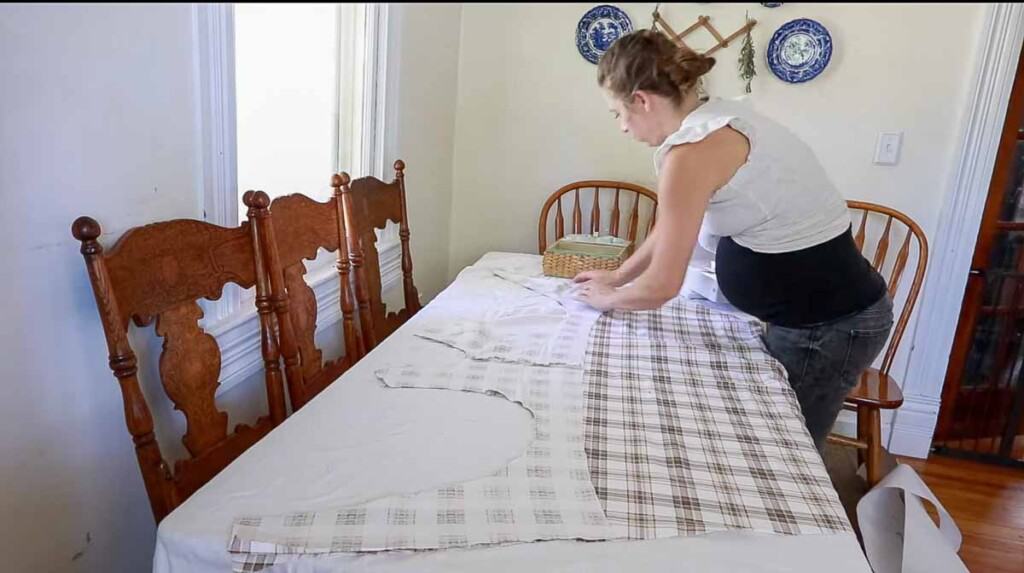
Lay the main apron piece down on a table or flat surface, pattern side up. Place the interfacing piece right-side down, matching up with main piece and pin.
Sew all the way around, leaving the tops of the straps and the bottom open.
Around all the curves of the straps and neckline, cut little slits just around the curves. Don’t cut into the seam line. This will help it lay flat.
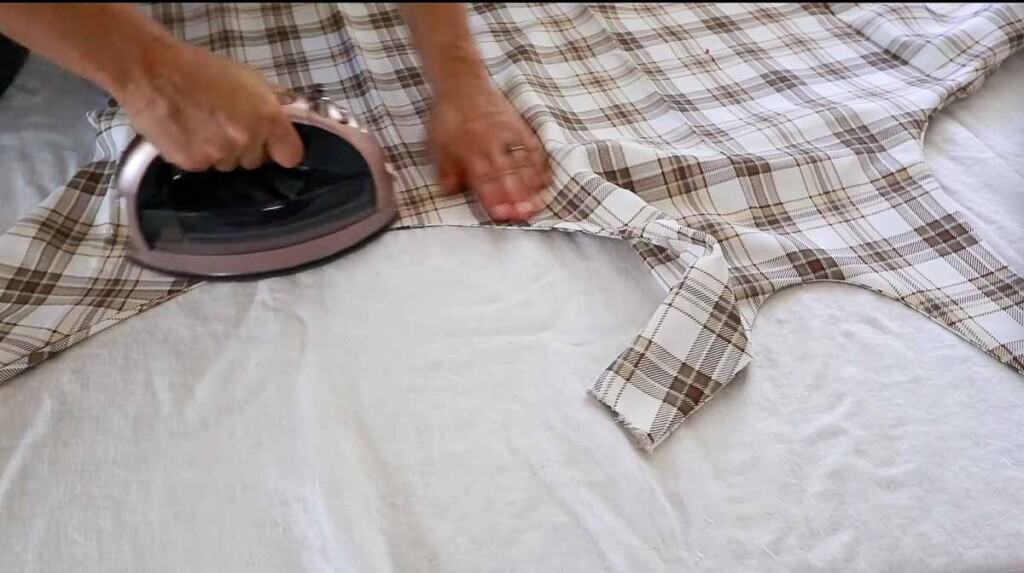
Turn the straps right side out and press flat.
Turn the raw edge on the open straps inward about 1/2 inch and press.
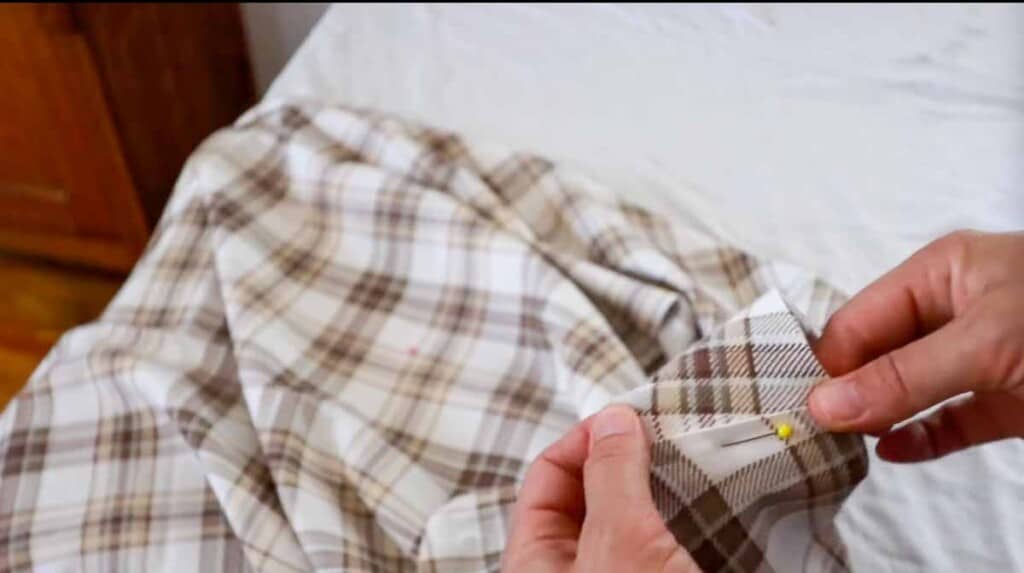
Create the cross by taking the strap from one side and attaching to the strap on the other side. Just place one of the straps into the opening of the other strap, pin, and stitch across to secure.
Create the Pockets
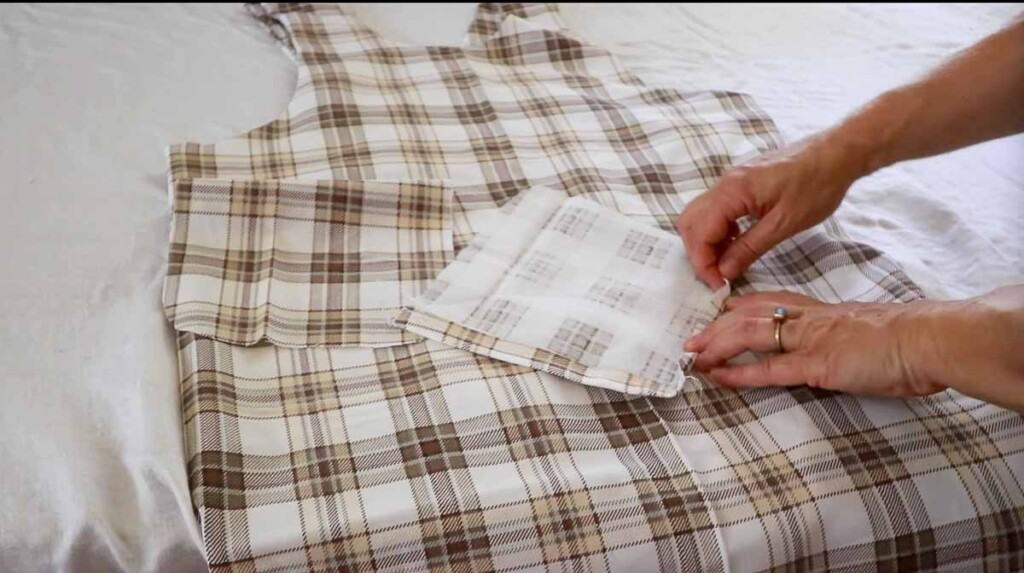
Take the pockets and fold over the top about 1/2 inch, then another 1/2 inch, press, and hem. Repeat with both pocket pieces.
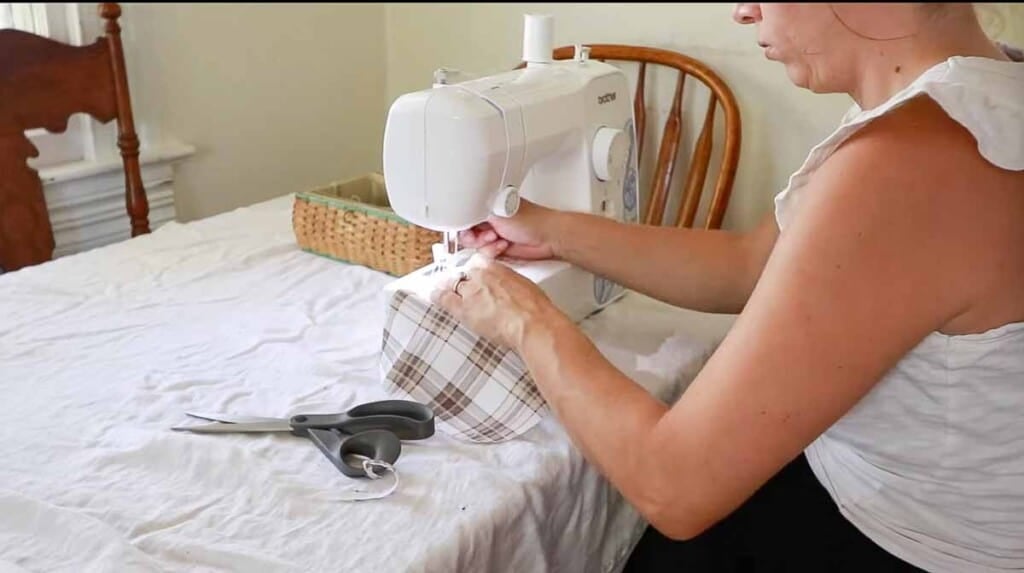
Fold over the sides of the pockets about 1/4 inch (there is a guide on the pattern, but I usually just estimate).
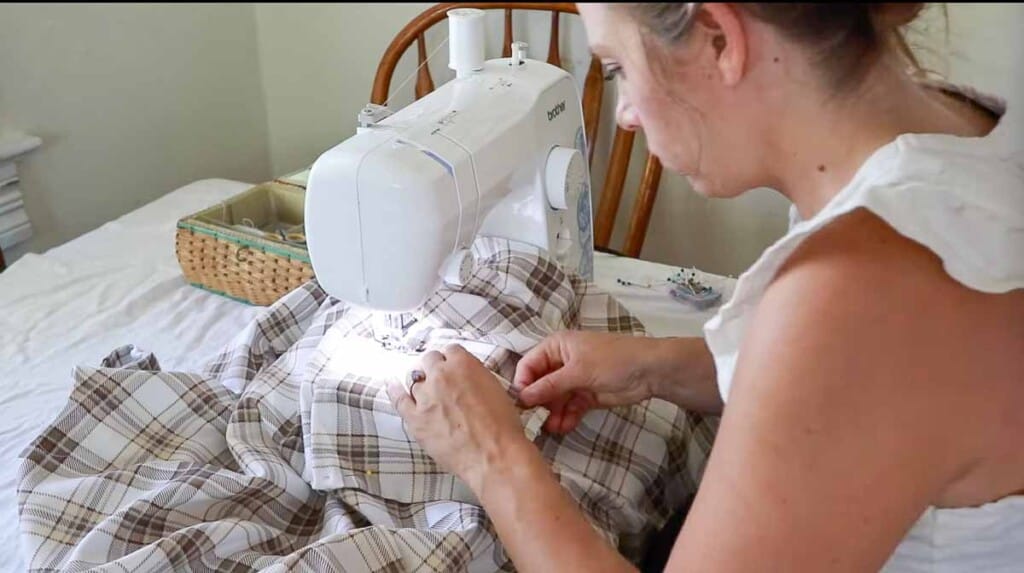
Place pockets in position and sew around the three sides, leaving the top opened.
Finish The Raw Edges
To finish off the apron, we need to finish the raw edges. You have two choices: you can hem it by folding it over 1/4 inch, then another 1/4 inch, and sewing, or you can use bias tape.
I decided to go with bias tape because of the curve.
To add bias tape, first sew a stay stitch about 3/8 of an inch from the raw edge. This is just a regular stitch that acts as a guide for the tape.
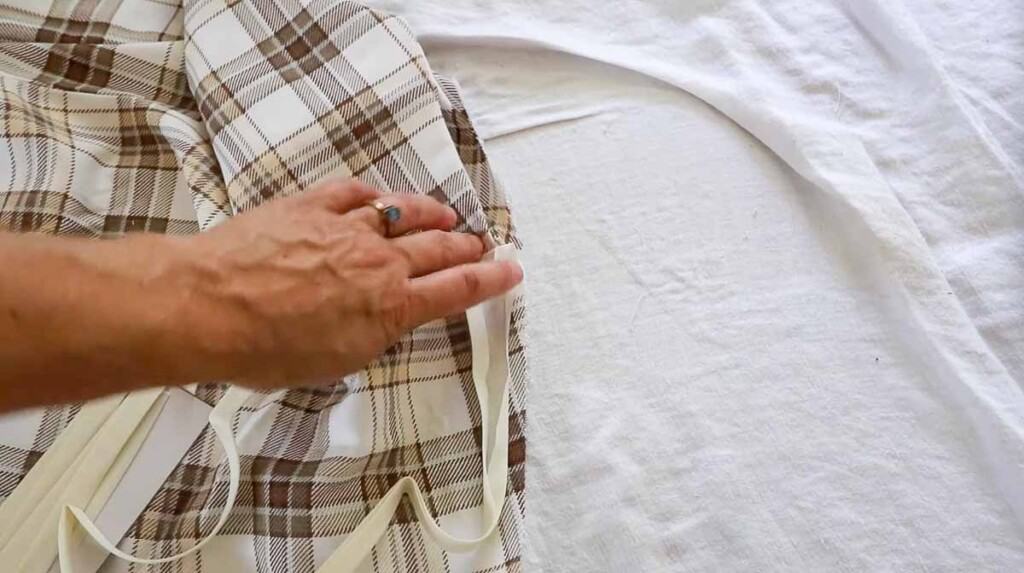
Starting on one edge, fold over the end of the bias tape about 1/4 inch, then pin it with the folded part of the bias tape around the stay stitch on the right side of the fabric. Pin it in place, then sew on the fold.
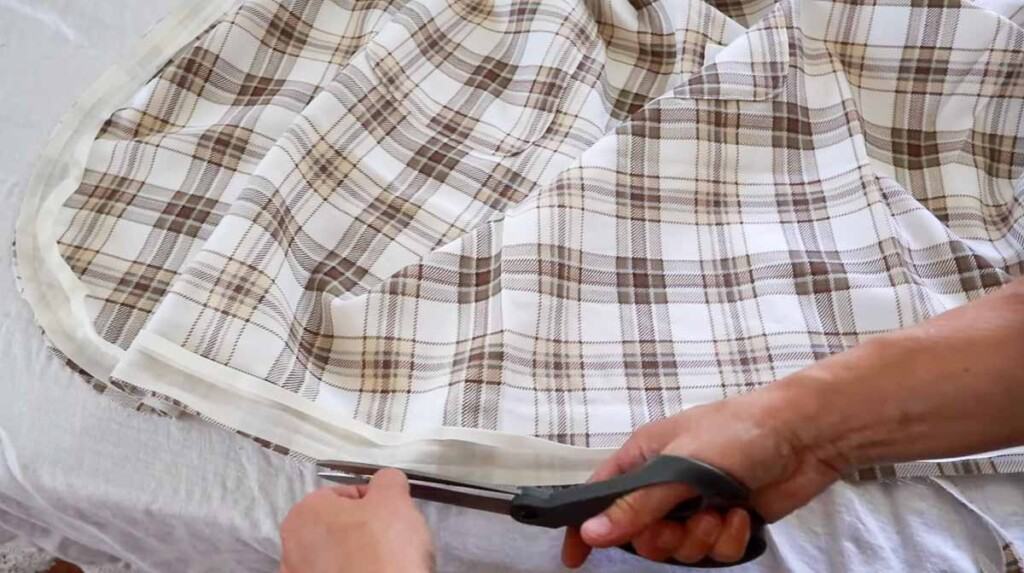
Trim any extra fabric to the edge of the bias tape.
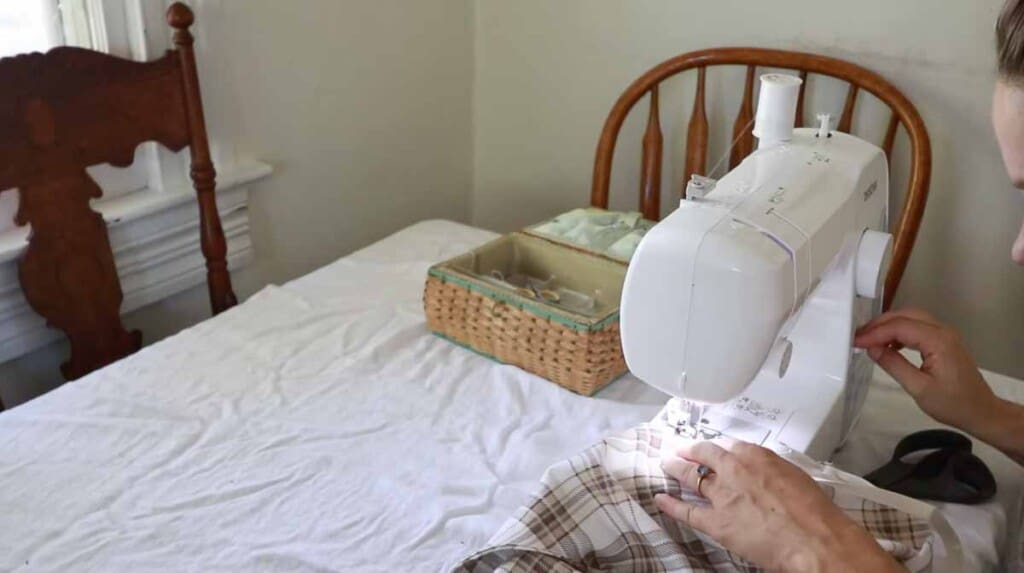
Sew bias tape following along the fold of the bias tape.
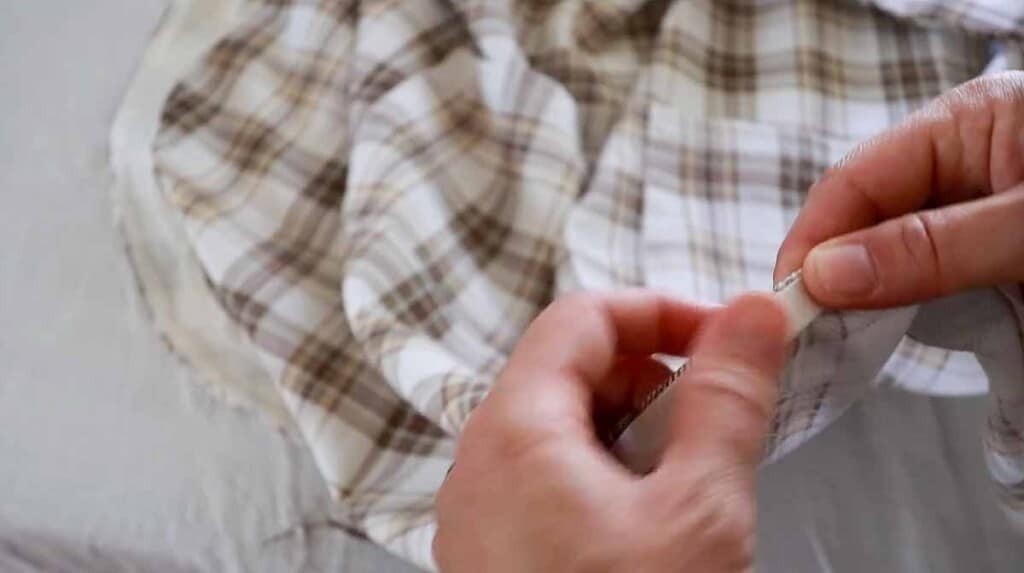
Fold over the bias tape and top stitch all the way around.
Repeat the same process on the raw edge of the interface.
Press, if needed, and you project is ready to go.
Print the pattern
Click HERE to download the pattern in full size.
Click HERE to print the pattern on your home printer.
Find More Sewing Projects:
- Ruffle Linen Pillow Cover Sewing Pattern
- How to Sew a Skirt
- DIY Ticking Stripe Curtain Sewing Tutorial
- DIY Tank Top – How to Sew a Tank Top
- Easy Girls Dress Sewing Tutorial- Bow in the Back Summer Dress
If you try this project and love it, I would love if you could come back and give it 5 stars!
Japanese Apron Tutorial With Free PDF Pattern
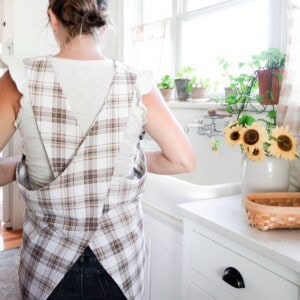
Equipment
- Sewing machine
- Sewing scissors
- Pins
- Iron
Ingredients
- 2 – 2 1/2 yards of fabric
- Coordinating thread
- Bias tape
Instructions
- Cut out the paper pattern.
- Wash, dry, and iron fabric.
- Fold the fabric in half and place the large, main section of the pattern along the fold and pin in place.
- Cut out the pattern.
- While the pattern is still pinned on, place pins to mark where the pockets belong. I added four pins at the corners to mark it.
- Lay the main apron piece down on a table or flat surface, pattern side up. Place the interfacing piece right-side down, matching up with main piece and pin.
- Sew all the way around, leaving the tops of the straps and the bottom open.
- Around all the curves of the straps and neckline, cut little slits just around the curves. Don’t cut into the seam line. This will help it lay flat.
- Turn the straps right side out and press flat.
- Turn the raw edge on the open straps inward about 1/2 inch and press.
- Create the cross by taking the strap from one side and attaching to the strap on the other side. Just place one of the straps into the opening of the other strap, pin, and stitch across to secure.
- Take the pockets and fold over the top about 1/2 inch, then another 1/2 inch, press, and hem. Repeat with both pocket pieces.
- Fold over the sides of the pockets about 1/4 inch (there is a guide on the pattern, but I usually just estimate).
- Place pockets in place and sew around the three sides, leaving the top opened.
- To finish off the apron, we need to finish the raw edges. You have two choices: you can hem it by folding it over 1/4 inch, then another 1/4 inch, and sewing, or you can use bias tape.
- To add bias tape, first sew a stay stitch about 3/8 of an inch from the raw edge. This is just a regular stitch that acts as a guide for the tape.
- Starting on one edge, fold over the end of the bias tape about 1/4 inch, then pin it with the folded part of the bias tape around the stay stitch on the right side of the fabric. Pin it in place, then sew on the fold.
- Trim any extra fabric to the edge of the bias tape.
- Fold over the bias tape and top stitch all the way around.
- Repeat the same process on the raw edge of the interface.
Press, if needed, and you project is ready to go.
Notes
- You have to place the the pattern very strategically so that it fits a two-yard piece of fabric. If you are only using two yards, you will have to cut the interfacing in two spots rather than on the fold, adding a little extra fabric to one side in order to sew it together down one side.
Nutrition information is automatically calculated, so should only be used as an approximation.






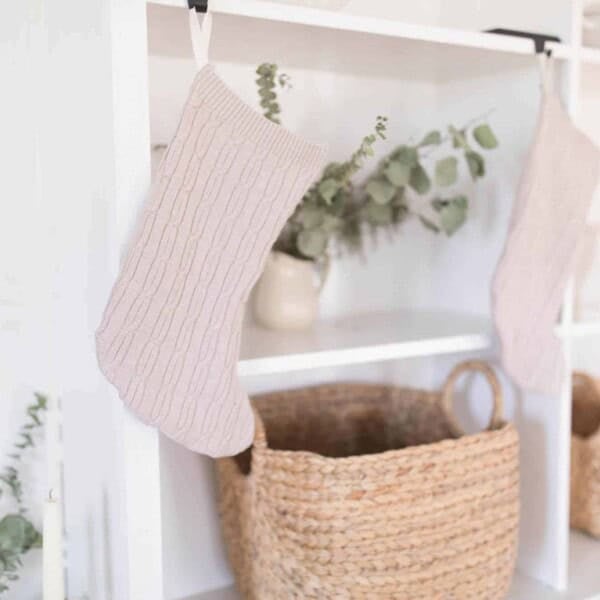

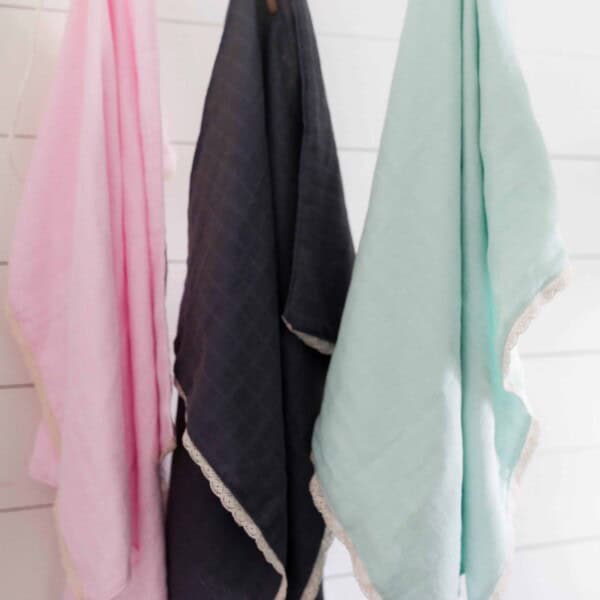
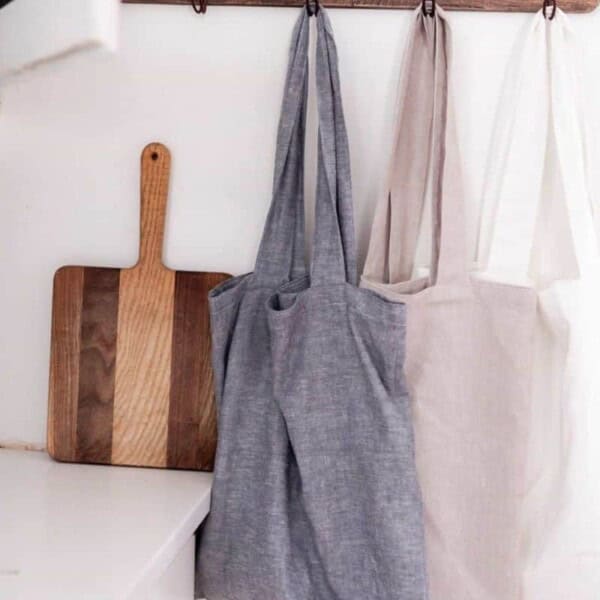






It says comes with a pattern. Am I missing something? I don’t see it
The pattern is at the bottom in the directions section.
Just a question. I want to make a memory apron for my aunt and I lo ed this design. If I am planning on making a double sided apron would I only need the one large piece but 2 cut out pieces instead of one? Does it make sense?
Yes, that’s correct.
This is a fine pattern for a small person. I’m 5’9″ tall and the apron is quite small. I made a paper apron first and am glad I did as I would have been a bit miffed had I cut out my piece of linen and discovered it was too small. I am an experienced seamstress so it was easy to enlarge. You should post the size of the finished garment and let people know that they will have to enlarge the pattern or move the pattern over from the fold for width and leave a space for length.
Thank you for your feedback!
Thank you for the pattern. I tweaked it to fit on 44” wide fabric, and no facing but instead did hem on all raw edges. Did French seam to connect at shoulders. Takes 1 yard for my petite frame. Perfect!
While this is adorable it’s is very small for a child or petite person
Thank you for your feedback!
I made a reversible version of this as a Christmas gift this year by skipping the interfacing pieces and sewing two of the main piece back to back. I’m new to sewing and not great at keeping hems even, so doing it this way was even easier than following the pattern entirely.
This whole project was extremely beginner-friendly and it was really fun to make. Thank you for sharing this!
Glad you enjoyed it!
What are the measurements of the finished apron from shoulder to the bottom? I would like to make one for someone, but she is only 4’10” so I want to make sure it fits without being too big.
Thanks!
I’m larger chested than you. Do I need to alter the pattern?
No, this apron is fits most.
No it doesn’t fit most
Instead of folding the fabric in half… only fold over enough for the big piece to fit. Then cut it out. That should give you a big enough piece left over to have a fold in the center front of the facing. 💖🌞🌵😷
Lisa this apron is just gorgeous. Love the fabric!
Thank you!
This pattern was a nice starting point for me for this style of apron. Changes I would make for myself(if I were to make it again) would be to lower the neckline a bit, and lower the placement of the pockets. I sewed a narrow hem at the bottom of the facing piece before sewing it to the apron piece. I turned the shoulders inside out and sewed the shoulder seam. A neater look. I sewed a 1/4 inch narrow hem on the bottom and them all the way around the rest of the apron. That was pretty easy. I’m still looking for a pattern that I really like so this was a great start.
Did you ever find a pattern that you like?